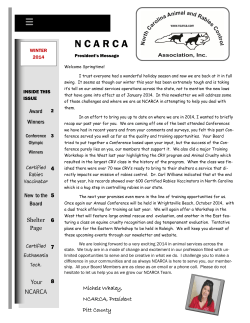
LINCOLNSHIRE FIRE & RESCUE BUILDINGS AND STRUCTURES 1 Building Types
LINCOLNSHIRE FIRE & RESCUE BUILDINGS AND STRUCTURES 1 Building Types and Components Lincolnshire Fire and Rescue’s Training Centre 1 AIM To provide students with a basic understanding of building design and the principal components. Lincolnshire Fire and Rescue’s Training Centre 2 LEARNING OUTCOMES At the end of the session students will be able to: • • • • State the commonly used construction materials and types. Identify types of doors and windows commonly used. List the principal components of a staircase. List the types of roof commonly found. Lincolnshire Fire and Rescue’s Training Centre 3 COMMON BUILDING MATERIALS • • • • • • Brick Block Stone Concrete Timber Metal Lincolnshire Fire and Rescue’s Training Centre 4 BUILDING BOARDS • • • • • • Fibre Plaster Asbestos Plywood Block Plastic Lincolnshire Fire and Rescue’s Training Centre 5 TYPES OF BUILDINGS • Solid or ‘traditional’ construction • Structural steel frame construction • Reinforced concrete construction • Modular system construction • Portal frame construction • Composite construction. Lincolnshire Fire and Rescue’s Training Centre 6 SOLID CONSTRUCTION • • • Solid load bearing walls • • • Cast iron columns Set back at upper floors Commonly made of brick, concrete blocks or stone Cast iron or timber beams Warehouses, mills, factories and offices. Lincolnshire Fire and Rescue’s Training Centre 7 BUILDINGS AND STRUCTURES Lincolnshire Fire and Rescue’s Training Centre 8 STRUCTURAL STEEL • • • • • High number of design options • Large shopping centres, sports centres and multi-storey offices. Skeletal framework often complex Loads carried by beams Structure is covered by cladding Large use of glass, polycarbonate and plastic Lincolnshire Fire and Rescue’s Training Centre 9 STRUCTURAL STEEL Roof spans between main beams Main beams Tie Beam Secondary beam Stanchions Floor spans between main beams Lincolnshire Fire and Rescue’s Training Centre 10 REINFORCED CONCRETE • Alternative to steel frame • Columns support beams on which are laid slab flooring sections • Columns, beams and slabs integrally cast to form a monolithic structure • Two common methods of construction. Lincolnshire Fire and Rescue’s Training Centre 11 REINFORCED CONCRETE(1) Pre cast reinforced concrete frame • Factory produced frame components • Transported for assembly on site • Similar techniques to steel frame. Lincolnshire Fire and Rescue’s Training Centre 12 REINFORCED CONCRETE(2) Composite construction • Utilises the advantages of modern lightweight structural steelwork • ‘Marriage’ between steelwork & pre cast concrete columns. Lincolnshire Fire and Rescue’s Training Centre 13 COMPOSITE CONSTRUCTION Concrete Spine beam Steel Spine beam. Gable columns Lincolnshire Fire and Rescue’s Training Centre 14 MODULAR STRUCTURES • Pre fabricated components • High design flexibility • Specially designed connectors • Encased in concrete to provide a degree of fire and corrosion protection. Lincolnshire Fire and Rescue’s Training Centre 15 MODULAR BUILDING Lincolnshire Fire and Rescue’s Training Centre 16 TYPICAL MODULAR CONNECTOR Lincolnshire Fire and Rescue’s Training Centre 17 HOLLOW BLOCK AND PLANK FLOORING R.C. edge beam Concrete ribs Hollow clay floor blocks Concrete topping Ceiling Voids finish Reinforcement Rib reinforcement Filler tiles Lincolnshire Fire and Rescue’s Training Centre 18 HOLLOW BLOCK AND PLANK Floor finish Cement/sand screed Void Internal support Typical hollow floor unit details Cement/sand Floor finish Grouted joints screed Typical channel section floor unit details Lincolnshire Fire and Rescue’s Training Centre 19 PRE CAST CONCRETE SLAB Lincolnshire Fire and Rescue’s Training Centre 20 DOORS, WINDOWS AND ROOFLIGHTS TYPES OF DOOR • • • • • • • Hinged Swing Revolving Sliding Folding Cantilever Roller shutter Lincolnshire Fire and Rescue’s Training Centre 21 HINGED DOORS • Most commonly found type • All close against a rebate on the door jamb • Four commonly found types Flush Panelled Ledged Metal Lincolnshire Fire and Rescue’s Training Centre 22 SWING DOORS • Pin hinges allow door to swing in any direction • Door jamb not fitted with a rebate • Often partially glazed using wired glass or copper glazing bars • Found in restaurants, department stores and hotels. Lincolnshire Fire and Rescue’s Training Centre 23 REVOLVING DOORS • Present an obstruction to firefighting operations unless dealt with • Usually 4 or 2 ‘wings’ • Designed to be collapsed down • Essential they are used in conjunction with a hinged door. Lincolnshire Fire and Rescue’s Training Centre 24 SLIDING DOORS • Solid or lattice construction • Widely used in commercial buildings • Can slide on one or both sides of an opening or into a central recess • Lattice type usually for security or to protect an area such as a lift or lift shaft. Lincolnshire Fire and Rescue’s Training Centre 25 FOLDING DOORS • Usually lightweight construction • Similar in design to hinged doors • Two or more leaves hinged together • Whole door opens to one side only • Often used to separate two rooms. Lincolnshire Fire and Rescue’s Training Centre 26 CANTILEVER DOORS • Door is counter balanced and pivoted so it rises upwards • Lies horizontal when open • Generally fits flush to the opening when closed • Usually found on garages. Lincolnshire Fire and Rescue’s Training Centre 27 ROLLER SHUTTERS • Nearly always made of steel • Small examples can be raised by hand • Large examples usually operated by means of gearing and handle or chain and block • Usually found on commercial premises. Lincolnshire Fire and Rescue’s Training Centre 28 FIRE DOORS A standard fire door will: • • Serve to contain the outbreak of fire • A closed door restricts oxygen movement, thus helping to starve the fire Restrict the spread of fire gases into otherwise unaffected parts of the building Lincolnshire Fire and Rescue’s Training Centre 29 WINDOWS • Allow natural light into a building • Serve to provide ventilation to rooms • Generally two types, referred to according to the method of opening Casement Sash Lincolnshire Fire and Rescue’s Training Centre 30 CASEMENT WINDOWS • The simplest form consists of a rectangular frame with the casement hung on it • When more than one casement can be opened it is referred to as a 2,3 or 4 light casement. Lincolnshire Fire and Rescue’s Training Centre 31 VENTLIGHT TRANSOM. FRAME CASEMENT DEADLIGHT Lincolnshire Fire and Rescue’s Training Centre 32 SASH WINDOWS • Pivoted sash - opening part supported by pivots at each side of opening part of window or top and bottom • The term ‘SASH’ refers to the opening portion and includes the glass and the surround • Partially inside and outside of opening when open. Lincolnshire Fire and Rescue’s Training Centre 33 SASH WINDOWS Sliding sash windows • Slide vertically • Double hung is the common form of this type of sash, both sashes slide vertically in the frame • Another type consists of two sashes, one or both of which can be opened horizontally Lincolnshire Fire and Rescue’s Training Centre 34 Lincolnshire Fire and Rescue’s Training Centre 35 STAIRS AND ROOFS Lincolnshire Fire and Rescue’s Training Centre 36 STAIRS Common materials • • • • • Wood Stone Pre cast concrete Steel Composite Lincolnshire Fire and Rescue’s Training Centre 37 STAIRS RISER NOSING TREAD CAPPING STRING BEARER Lincolnshire Fire and Rescue’s Training Centre 38 STAIRS HEADROOM BANNISTER RISE NEWEL POST GOING RUN SPANDREL PITCH LINE Lincolnshire Fire and Rescue’s Training Centre 39 ROOF DESIGN • Flat roofs • Pitched roofs – Mansard – Trussed – Portal or ridge-framed Lincolnshire Fire and Rescue’s Training Centre 40 PITCHED ROOFS Lincolnshire Fire and Rescue’s Training Centre 41 PITCHED ROOFS Lincolnshire Fire and Rescue’s Training Centre 42 CONFIRMATION Assessments will be based on this lesson and the corresponding study note Learning Outcomes • State the most commonly used construction materials and types • Identify types of doors and windows commonly used • • List the principal components of a staircase List the types of roof commonly found. Lincolnshire Fire and Rescue’s Training Centre 43 THE END Lincolnshire Fire and Rescue’s Training Centre 44
© Copyright 2025









